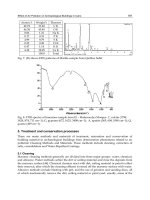ASSESSMENT, TREATMENT, AND PREVENTION OF SUICIDAL BEHAVIOR - PART 1 potx
Bạn đang xem bản rút gọn của tài liệu. Xem và tải ngay bản đầy đủ của tài liệu tại đây (407.85 KB, 50 trang )
ASSESSMENT, TREATMENT,
AND PREVENTION OF
SUICIDAL BEHAVIOR
Edited by
ROBERT I. YUFIT and DAVID LESTER
John Wiley & Sons, Inc.
ffirs.qxd 8/2/04 12:11 PM Page iii
ffirs.qxd 8/2/04 12:11 PM Page iii
ASSESSMENT, TREATMENT,
AND PREVENTION OF
SUICIDAL BEHAVIOR
ffirs.qxd 8/2/04 12:11 PM Page i
ffirs.qxd 8/2/04 12:11 PM Page ii
ASSESSMENT, TREATMENT,
AND PREVENTION OF
SUICIDAL BEHAVIOR
Edited by
ROBERT I. YUFIT and DAVID LESTER
John Wiley & Sons, Inc.
ffirs.qxd 8/2/04 12:11 PM Page iii
This book is printed on acid-free paper.
Copyright © 2005 by John Wiley & Sons, Inc. All rights reserved.
Published by John Wiley & Sons, Inc., Hoboken, New Jersey.
Published simultaneously in Canada.
No part of this publication may be reproduced, stored in a retrieval system, or transmitted in any
form or by any means, electronic, mechanical, photocopying, recording, scanning, or otherwise,
except as permitted under Section 107 or 108 of the 1976 United States Copyright Act, without
either the prior written permission of the Publisher, or authorization through payment of the
appropriate per-copy fee to the Copyright Clearance Center, Inc., 222 Rosewood Drive, Danvers,
MA 01923, (978) 750-8400, fax (978) 646-8600, or on the web at www.copyright.com. Requests
to the Publisher for permission should be addressed to the Permissions Department, John Wiley
& Sons, Inc., 111 River Street, Hoboken, NJ 07030, (201) 748-6011, fax (201) 748-6008.
Limit of Liability/Disclaimer of Warranty: While the publisher and author have used their best
efforts in preparing this book, they make no representations or warranties with respect to the
accuracy or completeness of the contents of this book and specifically disclaim any implied
warranties of merchantability or fitness for a particular purpose. No warranty may be created or
extended by sales representatives or written sales materials. The advice and strategies contained
herein may not be suitable for your situation. You should consult with a professional where
appropriate. Neither the publisher nor author shall be liable for any loss of profit or any other
commercial damages, including but not limited to special, incidental, consequential, or other
damages.
This publication is designed to provide accurate and authoritative information in regard to the
subject matter covered. It is sold with the understanding that the publisher is not engaged in
rendering professional services. If legal, accounting, medical, psychological or any other expert
assistance is required, the services of a competent professional person should be sought.
Designations used by companies to distinguish their products are often claimed as trademarks.
In all instances where John Wiley & Sons, Inc. is aware of a claim, the product names appear in
initial capital or all capital letters. Readers, however, should contact the appropriate companies
for more complete information regarding trademarks and registration.
For general information on our other products and services please contact our Customer Care
Department within the United States at (800) 762-2974, outside the United States at (317) 572-
3993 or fax (317) 572-4002.
Wiley also publishes its books in a variety of electronic formats. Some content that appears in
print may not be available in electronic books. For more information about Wiley products, visit
our web site at www.wiley.com.
Library of Congress Cataloging-in-Publication Data:
Assessment, treatment, and prevention of suicidal behavior / edited by Robert I. Yufit and
David Lester.
p. cm.
Includes bibliographical references and index.
ISBN 0-471-27264-7 (cloth)
1. Suicidal behavior—Diagnosis 2. Suicidal behavior—Treatment. 3.
Suicide—Prevention. I. Yufit, Robert I., 1930– II. Lester, David, 1942–
RC569.A.776 2004
616.85′844506—dc22
2004042224
Printed in the United States of America.
10987654321
➇
ffirs.qxd 8/2/04 12:11 PM Page iv
Change is a constant in life. By building coping strengths the clinician can
help the more vulnerable person cross the therapy bridge and prevent the
extreme failure of adaptation: suicide.
We dedicate this book to the mental health clinicians who help suicidal
patients build the therapy bridge from hopelessness to wellness, from
vulnerability to successful coping with change.
ffirs.qxd 8/2/04 12:11 PM Page v
ffirs.qxd 8/2/04 12:11 PM Page vi
vii
Contents
Foreword ix
Norman L. Farberow
About the Editors xiii
Contributors xv
1
Introduction 1
Robert I. Yufit and David Lester
PART ONE
Screening and Assessment
2
Clinical Use of Suicide Assessment Scales: Enhancing Reliability
and Validity through the Therapeutic Relationship 7
James R. Rogers and Kimberly M. Oney
3
Assessment of Suicide: Beck’s Scales for Assessing
Mood and Suicidality 29
Mark A. Reinecke and Rogina L. Franklin-Scott
4
Minnesota Multiphasic Personality Inventories (MMPI/MMPI-2,
MMPI-A) and Suicide 63
Alan F. Friedman, Robert P. Archer, and Richard W. Handel
5
Rorschach Contributions to Assessment of Suicide Risk 93
Ronald J. Ganellen
6
Assessing the Vital Balance in Evaluating Suicidal Potential 121
Robert I. Yufit
PART TWO
Intervention and Treatment of Suicidality
7
The Classic Systems of Psychotherapy and Suicidal Behavior 145
David Lester
ftoc.qxd 8/2/04 12:11 PM Page vii
viii Contents
8
Crisis Intervention in the Context of Outpatient Treatment of
Suicidal Patients 163
John Kalafat and Maureen M. Underwood
9
No-Suicide Contracts 181
Lillian M. Range
10
Cognitive-Behavioral Therapy with Suicidal Patients 205
Mark A. Reinecke and Elizabeth R. Didie
11
Voice Therapy: A Treatment for Depression and Suicide 235
Lisa Firestone
12
Dialectical Behavior Therapy 279
David Lester
13
The Widening Scope of Family Therapy for the Elderly 291
Joseph Richman
14
Group Therapy and Suicide 313
Robert R. Fournier
PART THREE
Special Issues
15
Easing the Legacy of Suicide 337
David Lester
16
Coping with Suicide in the Schools: The Art and the Research 347
Antoon A. Leenaars, David Lester, and Susanne Wenckstern
17
Helping College Students Cope with Suicidal Impulses 379
Morton M. Silverman
18
Suicide Terrorism 431
Ariel Merari
Author Index 455
Subject Index 473
ftoc.qxd 8/2/04 12:11 PM Page viii
ix
Foreword
It doesn’t seem too long ago that the best answer to the question “How
do you know if someone is suicidal?” was (only half-jokingly) “Just ask
him/her.” Often, it was the only answer in those early years when the
first suicide prevention centers and crisis centers were established and
the field of suicidology was just beginning. First efforts turned to those
most used psychological tests and scales, such as the Rorschach, the
TAT, and the MMPI, but these were repeatedly unsuccessful or only
minimally helpful. Accordingly, clinicians called on their own resources
and made up their own scales using feelings, behaviors, family history,
psychosocial factors, medical status, epidemiological and demographic
aspects drawn from their own contacts with suicidal individuals along
with already existing sociological studies. While these first scales and
questionnaires were helpful, they were drawn primarily from clinical
experiences with suicidal callers and patients that featured an assess-
ment of immediate short-term risk or the probability of a lethal acting
out occurring within the next 24 hours. Kaplan and Lindemann’s crisis
theory that was developing at about the same period provided a handy
theoretical underpinning for the responses that developed.
The difficulty has been that in the intervening years, as studies multi-
plied and information about the vagaries of suicide increased, its com-
plexity and its multidimensional aspects became more and more
apparent. Treatment had to expand to include chronic and long-term sui-
cidal behavior, direct and indirect suicidal behavior, intentional planned
and impulsive unplanned behavior, and so on. It became apparent that no
one theory and no one therapy could fit all the many manifestations of
self-destructive feelings and behaviors. It was increasingly recognized
that suicide encompassed a complex, complicated, wide-ranging net-
work of conditions, and that its assessment could only be partial with
flast.qxd 8/2/04 12:07 PM Page ix
x Foreword
any one scale or questionnaire. Supplemental procedures and additional
sources were necessary to understand more completely the presenting
situation. This important fact is repeatedly noted in many chapters in
this book, especially in the section on assessment.
This book plays a vital role in helping the reader keep pace with the
many changes in assessment that have occurred since those early days.
In some instances, it brings the reader up to date with familiar tests by
giving their history and indicating its current status, whether useful ap-
plicability (Beck scales), or reaffirmations of doubtful help (MMPI,
Rorschach in part). But even with unconfirmed scales, there are indica-
tions of ways in which they might be useful, as in providing information
about specific aspects like impulsivity, handling of guilt feelings, or
management of anger and similar conditions that contribute to evaluat-
ing suicide status.
A comprehensive view of the major areas of assessment, treatment,
and prevention in suicide prevention since its beginnings in the 1950s re-
veals an uneven development, with studies of treatment of the suicidal
individual at first lagging behind the studies of assessment. Within the
area of treatment itself, activity was unequal with the majority of the
studies focusing on the critical area of crisis response and management
as suicide prevention centers appeared throughout the United States and
the world. However, as reflected in this book, the focus has shifted and
many studies have appeared on individual therapies and long-term treat-
ments, with at least two of the therapies reporting success in working
with people at risk of suicide—cognitive behavior therapy and dialecti-
cal behavior therapy. For those who still prefer to work with dynamics,
there is voice therapy and transactional analysis with their specialized
features for providing insights, along with gestalt therapy, interpersonal
therapy, insight therapy, and others. Neurobiological aspects and the de-
velopment of medications specifically targeting the feelings and atti-
tudes most often found in suicide now play an increasingly important
role. Guidelines have been formulated specifically for treating the sui-
cidal patient that provide both short-term and long-term procedures and
goals, increasing confidence in achieving positive outcomes. Regardless
of the kind of therapy practiced, the summaries and conclusions of the
chapters in Part Two—the Treatment section of this book—will help
every therapist in providing effective and efficient practice with suicidal
flast.qxd 8/2/04 12:07 PM Page x
patients. Like an added special treat in an 18-course intellectual dinner,
there is a thoughtful, considered report on the re-emergence of suicide as
a weapon of terrorism.
This book provides an invaluable update on the current status of as-
sessment, treatment, and prevention of suicidal behavior.
N
ORMAN
L. F
ARBEROW
,P
H
D
Foreword xi
flast.qxd 8/2/04 12:07 PM Page xi
flast.qxd 8/2/04 12:07 PM Page xii
xiii
About the Editors
Robert I. Yufit, PhD, ABPP, is associate professor at the Feinberg
School of Medicine at the Northwestern University Medical School and
in private practice, focusing primarily on the assessment and treatment
of suicidal individuals. He is past-president of the American Association
of Suicidology. He is associate editor of the journal, Suicide and Life-
Threatening Behavior, as well as co-founder of the Illinois Association of
Suicidology.
David Lester, PhD, is professor of Psychology at the Richard Stockton
College of New Jersey. He has written extensively on both suicide and
murder. He was Director of Research and Evaluation at the Suicide Pre-
vention and Crisis Service in Buffalo, New York, and is past-president of
the International Association for Suicide Prevention.
flast.qxd 8/2/04 12:07 PM Page xiii
flast.qxd 8/2/04 12:07 PM Page xiv
xv
Robert P. Archer, PhD, ABPP
Eastern Virginia Medical School
Norfolk, Virginia
Elizabeth R. Didie, PhD
Northwestern Memorial Hospital
Chicago, Illinois
Lisa Firestone, PhD
Glendon Association and
Adjunct Faculty
University of California
Santa Barbara, California
Robert R. Fournier, PhD
Private Practice and Department of
Veterans Affairs
Cape Cod, Massachusetts
Rogina L. Franklin-Scott, PhD
Albert Einstein College of Medicine
Bronx, New York
Alan F. Friedman, PhD
The Feinberg School of Medicine
Northwestern University Medical
School and Independent Practice
Chicago, Illinois
Ronald J. Ganellen, PhD, ABPP
Department of Psychiatry and
Behavioral Sciences
The Feinberg School of Medicine
Northwestern University Medical
School
Chicago, Illinois
Richard W. Handel, PhD
Department of Psychiatry and
Behavioral Sciences
Eastern Virginia Medical School
Norfolk, Virginia
John Kalafat, PhD
Rutgers University
Piscataway, New Jersey
Antoon A. Leenaars, PhD
Windsor, Canada
David Lester, PhD
The Richard Stockton College of
New Jersey
Pomona, New Jersey
Contributors
flast.qxd 8/2/04 12:07 PM Page xv
xvi Contributors
Ariel Merari
Department of Psychology
Tel Aviv University
Tel Aviv, Israel
Kimberly M. Oney, MA
Department of Counseling
The University of Akron
Akron, Ohio
Lillian M. Range, PhD
University of Southern Mississippi
Hattiesburg, Mississippi
Mark A. Reinecke, PhD
Division of Psychology
The Feinberg School of Medicine
Northwestern University Medical
School
Chicago, Illinois
Joseph Richman, PhD
Albert Einstein School of Medicine
Bronx, New York
James R. Rogers, PhD
Department of Counseling
University of Akron
Akron, Ohio
Morton M. Silverman, MD
Pritzker School of Medicine
University of Chicago,
Chicago, Illinois
Maureen M. Underwood, ACSW
Private Practice
Morristown, New Jersey
Susanne Wenckstern
The Greater Essex County District
School Board
Ontario, Canada
Robert I. Yufit, PhD, ABPP
Division of Psychology
The Feinberg School of Medicine
Northwestern University Medical
School and Independent Practice
Chicago, Illinois
flast.qxd 8/2/04 12:07 PM Page xvi
ASSESSMENT, TREATMENT,
AND PREVENTION OF
SUICIDAL BEHAVIOR
flast.qxd 8/2/04 12:07 PM Page xvii
flast.qxd 8/2/04 12:07 PM Page xviii
1
CHAPTER 1
Introduction
Robert I. Yufit and David Lester
The scourge of suicidal behavior touches many lives and knows few
boundaries. About 30,000 people are known to take their own lives in the
United States each year. In addition, many of those deaths recorded as ac-
cidental or undetermined by coroners and medical examiners may have
been motivated by suicidal intent. Suicide is the eighth leading cause of
death in this country and, among young people 15 to 19 years of age,
suicide is exceeded in frequency as a cause of death only by accidental
deaths. Suicide occurs in every country in the world and among all racial
and ethnic groups. Being destitute and alone increases the risk of suicide,
but suicide occurs in all groups of the population, the young and the old,
the rich and the poor, the famous and those who remain unnoticed.
For each suicidal death that occurs, there are many more nonfatal sui-
cidal acts ranging in seriousness from mild overdoses and superficially
inflicted cuts to potentially lethal acts such as jumping from a high place
or ingesting a corrosive poison. It is estimated that there are about a quar-
ter of a million nonfatal suicide attempts each year in the United States.
Among people who have made a suicide attempt, about 15 percent will
eventually take their own lives; among those who kill themselves, about
one-third have previously attempted suicide.
These facts attest to the importance of assessing suicidal risk accu-
rately, providing effective treatment for people who have attempted
suicide or who appear to be likely to do so, and implementing preven-
tive strategies that can minimize the emergence of suicidal impulses.
Since suicide is unique among causes of death in that it is entirely the
result of d
ecisions and actions made by the deceased person, it should
c01.qxd 8/2/04 10:57 AM Page 1
2 I nt ro duc tion
be preventable by helping people cope with the chronic predispositions
that increase their risk of suicide and the temporary stressors with
which they are confronted.
To help clinicians who work with suicidal clients, this book provides
a current and comprehensive source of information and guidelines for
assessing, treating, and preventing suicidal behavior.
The book consist of three sections: Part One, “Screening and Assess-
ment,” examines empirically based assessment techniques that measure
important mood states, personality traits, and attitudes that are associ-
ated with suicidal behavior. These assessment methods help define the
dimensions of vulnerability to becoming self-destructive and also assess
the risk of such behavior occurring.
In Chapter 2, James Rogers and Kimberley Oney examine those scales
that measure the suicidality of clients. The diversity of these scales means
that each clinician and each researcher may use a different scale. As a
consequence, their definitions of and judgments about the suicidality of
clients may differ considerably. Rogers and Oney discuss the empirical
evidence for the reliability and validity of these scales but, more im-
portantly, they discuss how the nature of the relationship between the
psychologist and the client can affect this reliability and validity. They
propose a model for the clinician to follow that may increase the useful-
ness of these scales in clinical practice.
One of the most thoughtful and prolific developer of scales to assess
the suicidality, mood, and cognitive functioning of clients is Aaron Beck.
His scales are based on his theory of psychiatric disorder and the tech-
niques of cognitive therapy that he has proposed. These scales have been
used in hundreds, if not thousands, of empirical studies, and so their
reliability and validity has been well established. In Chapter 3, Mark
Reinecke presents current data on these scales that are of immense value
to clinicians working with depressed and suicidal clients.
Several assessment techniques have been used for more than 50
years with suicidal clients. In Chapter 4, Alan Friedman, Robert Archer,
and Richard Handel review the use of the old MMPI and the more recent
MMPI-2 and MMPI-A with suicidal clients. Not only are these measures
still used extensively with potentially suicidal clients, there are also large
sets of archival data that have included these measures. Thus, the MMPI
in its various forms remains useful for the evaluation of clients, and it
c01.qxd 8/2/04 10:57 AM Page 2
Introduction 3
also enables archival data sets to be re-examined as new findings on the
MMPI become disseminated.
In Chapter 5, Ronald Ganellen reviews research on the use of
the Rorschach Ink Blot Test with suicidal clients. Although projective
tests such as the Rorschach are not favored by all clinicians, some clini-
cians still use them and, again, there are large archival data sets from
the Rorschach.
Robert Yufit has been involved in research on the assessment of sui-
cidal clients for many years, and he has developed his own approach to
assessment based on Karl Menninger’s concept of the Vital Balance, a
balance between the strengths and weaknesses of the client. He presents
assessment techniques to evaluate both vulnerability and coping skills in
his approach in Chapter 6.
Part Two, “Intervention and Treatment of Suicidality,” compares
several different approaches for conducting psychotherapy with sui-
cidal clients. The classic systems of psychotherapy have rarely ad-
dressed suicidal clients, but in Chapter 7, David Lester brings together
the few suggestions that these classic systems (such as psychoanalysis,
person-centered therapy, and Gestalt therapy) have made.
Most suicide prevention centers are based on a crisis intervention ap-
proach to treating the suicidal client. They do this partly because the
suicidal clients they encounter are in crisis, but also because the centers
are set up to deal with clients only on a short-term basis and use tele-
phone counseling, both of which limit the techniques that the counselor
can use. In Chapter 8, John Kalafat and Maureen Underwood discuss
the principles of crisis intervention for suicidal clients.
Having suicidal clients sign contracts that they will not commit sui-
cide has become a common but controversial tactic for psychotherapists.
Lillian Range reviews the opinions on this tactic, as well as the research
on its usefulness, in Chapter 9.
There are three systems of psychotherapy which have addressed the
suicidal client in detail. Mark Reinecke and Elizabeth Didie present
cognitive-behavioral therapy in Chapter 10, Lisa Firestone presents
voice therapy in Chapter 11, and David Lester presents dialectical be-
havior therapy approach in Chapter 12.
For many years, Joseph Richman has been the lone therapist advocat-
ing the relevance of family therapy for suicidal clients, and he presents
c01.qxd 8/2/04 10:57 AM Page 3
4 I nt ro duc tion
his approach in Chapter 13. Suicidal clients have been placed into group
therapy since the 1960s when the Los Angeles Suicide Prevention Cen-
ter first tried this approach. Robert Fournier discusses current practices
for group therapy with suicidal clients in Chapter 14.
The final part presents special issues that have relevance today. First,
discussions of rational suicide and physician-assisted suicide have be-
come common in recent years, but few psychotherapists have explored
how they might become involved in these decisions. In Chapter 15,
David Lester discusses the role that counselors and psychotherapists
might play in helping the suicidal client come to a decision and in help-
ing the significant others come to terms with the decision.
There is great concern with suicidal behavior in adolescents and stu-
dents, particularly because many nations have experienced a rise in the
suicide rates of young people in recent years and because suicide is one
of the leading causes of death for the youth. Antoon Leenaars, David
Lester, and Susanne Wenckstern discuss suicide prevention in schools in
Chapter 16, while Morton Silverman discusses tactics for helping sui-
cidal college students in Chapter 17.
Finally, we hear much about suicide terrorists who blow themselves
up with bombs in their efforts to bring about political change in nations
as disparate as Iraq, Chechnya, and Sri Lanka. Ariel Merari concludes
this volume by discussing the problems and issues that suicide terror-
ists present.
This compilation of information concerning the assessment, treatment,
and prevention of suicidal behavior is addressed to nurses, psychiatrists,
psychologists, social workers, and other mental health professionals, who
will find it useful in providing services to patients and clients who have
been or may become suicidal or who indulge in self-harm behavior. In ad-
dition to its primary audience of mental health professionals, this book
will prove valuable to educators, school counselors, and others who are
actively engaged with young people and in a position to help them learn
improved coping skills. These readers are likely to appreciate the guid-
ance provided for structuring programs to promote coping skills in ado-
lescents that can reduce their potential for suicide. We hope that this book
will provide the needed advances in information to help us cross the
bridge to a better understanding of how to help suicidal people.
c01.qxd 8/2/04 10:57 AM Page 4









